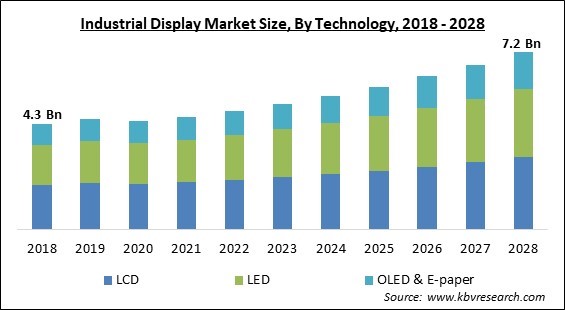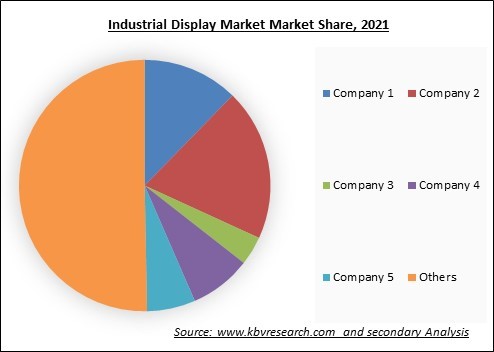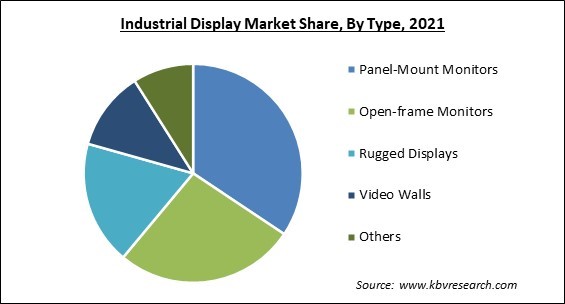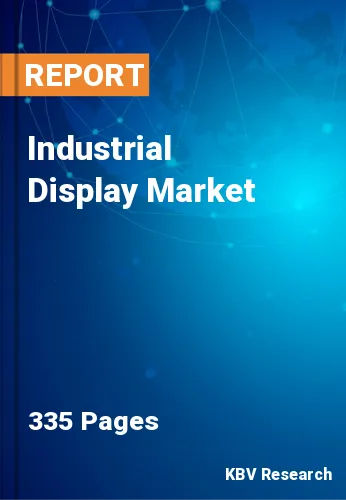The Global Industrial Display Market size is expected to reach $7.2 billion by 2028, rising at a market growth of 6.9% CAGR during the forecast period.
Industrial displays are used to show current operations and predicted results. These displays are more important in ensuring that the industry runs smoothly. As a result, the industry is among the most shows that there is significant in terms of growth. Furthermore, the global shift in technology and automated systems drive market growth. Moreover, robust display wireless connection, and technologically advanced push market growth during the forecast period.

The increasing adoption of multi-featured Human-Machine Interface (HMI) devices, the Industrial Internet of Things (IIoT), and the popularity of smart industrial displays are some of the factors driving market growth. The displays' innovative features, such as touchpad frames and fully automated touch detection systems; RFIDs; Ethernet connectivity; and ability to withstand high temperature changes, shock, motion, dust, scrape, and chemicals, are catapulting the industry forward.
Even though displays are a viable substitute for manual methods and outdated push-button technology, the industry offers a large investment opportunity. To keep up with changing industrial needs, the market is differentiated by continuous technological developments. Low-Temperature Poly-Silicon (LTPS), Liquid Crystal Display (LCD), Thin-Film-Transistor (TFT), Digital Light Processing (DLP), and Color Filter (CF) are some of the most recent industry innovations.
The growing demand for multi-featured HMIs and smart touch screen displays is driving advancement and innovation. Regulations governing the manufacture and sale of industrial displays differ by region or country. For example, the European Union Law on the Restriction of Hazardous Substances (RoHS) has limited the use of cadmium, lead, mercury, and hexavalent chromium in electronic equipment, as well as flame retardants such as Polybrominated Diphenyl Ethers (PBDE) or Polybrominated Biphenyls (PBB).
Society and the global economy are suffering greatly as a result of the COVID-19 pandemic. The supply chain is being impacted by the outbreak, whose effects are growing every day. Stock market turbulence, a decline in corporate confidence, a considerable delay in the distribution chain, and a rise in customer apprehension are all being brought on by it. European nations under lockdown have suffered major losses in trade and revenue as a result of the suspension of manufacturing operations in the area. The COVID-19 pandemic has had a substantial impact on manufacturing and production processes, slowing the growth of the industrial display sector in 2020.
The enormous industrial displays are still in demand because they offer an efficient means of communication even though the billboard business is still feeling the heat of environmental rules. High-performance huge industrial displays are also increasingly essential for accessibility of real-time data that fuels productivity as industrial automation and robotics pick up speed. Applications for large industrial displays are anticipated to take on a new dimension as the need for HMIs to monitor production processes surges. Manufacturers would continue to place a strong emphasis on design differentiation in order to close sales, which has sparked the development of a number of flexible, foldable, and thinner new-age displays.
The creation of thin, effective, and bright displays is made possible by the thin films of organic light-emitting (OLED) materials that emit light when electricity is applied to them. It is anticipated that OLEDs would replace prevailing technologies in the display ecosystem. As a result, a sizable number of businesses have started to increase their investment in OLED study and innovation. OLED industrial displays are dominating the market because to their cutting-edge features, such as higher contrast, quicker response times, and a broader operating temperature range than LCDs. OLED micro displays are now often used in EVFs and HMDs because they outperform conventional LCD and LCoS micro display technologies.

The leading players in the market are competing with diverse innovative offerings to remain competitive in the market. The below illustration shows the percentage of revenue shared by some of the leading companies in the market. The leading players of the market are adopting various strategies in order to cater demand coming from the different industries. The key developmental strategies in the market are Product Launches, and Partnerships & Collaborations.
OLEDs are perfect for products like smartphones since people are more likely to replace these frequently than they are to replace a larger purchase, like a television. OLEDs are made of organic materials that are impacted by their surroundings, sensitive to moisture, and susceptible to screen degradation from exposure to heat and sunlight. OLED technology has a lot of advantages, but it also has a long list of drawbacks. Its advantages are quickly outweighed by problems with heat, moisture, loss of brightness, pixel burnout, and consumer expenditure.

On the basis of technology, the industrial display market is classified into LCD, LED, OLED and E-paper. The LCD segment acquired the highest revenue share in the Industrial Display Market in 2021. A flat panel display called a liquid crystal display (LCD) makes use of the liquid crystals' capacity to modulate light. Instead of emitting light directly to create images in color or monochrome, liquid crystals use a backlight or reflector. There are two primary categories of LCDs used in electronic devices like digital clocks and video players and those used in computers.
Based on type, the industrial display market is segmented into Rugged Displays, Open-frame Monitors, Panel-Mount Monitors, Marine Displays and Video Walls. The open-frame monitor segment registered a substantial revenue share in the Industrial Display Market in 2021. Open Frame Monitor (OFM) is primarily housed in a bare-metal container and typically does not have a bezel. Instead, it is normally delivered with a mounting metal flange on the outside. Electronic parts, such as the display controller A/D board, the harnesses, and maybe the internal power supply, are secured to the inside of the metal chassis.
By end-use, the industrial display market is categorized into Manufacturing, Mining & Metals, Chemical, Oil, and Gas, Energy & Power, and Others. The Chemical, Oil, and Gas segment registered a promising revenue share in the Industrial Display Market in 2021. Oil and gas have played an important role in the economic transformation, but the industry is entering a new era. Digital transformation can improve productivity and workplace safety while reducing the industry's environmental impact. Large industrial displays are especially important in the oil and gas industry, where comprehend rough environmental parameters, extreme temperatures, high levels of pollution, and operation is critical not only for safety but also for improving profitability.
Based on panel size, the industrial display market is fragmented into Up to 14”, 14-21”, 21-40”, and 40” and above. The 21-40” segment witnessed a substantial revenue share in the Industrial Display Market in 2021. It is due to the demand for touch screen computer parts in heavy-duty workplaces expected to drive the 21-40" panel size segment's growth. The anodized coatings on the monitors and touch screen panels, combined with the stainless-steel chassis, are intended to provide operators with greater durability and operation across a wide temperature range.
By application, the industrial display market is divided into HMI, Remote Monitoring, Interactive Display and Digital Signage. The HMI segment garnered the highest revenue share in the Industrial Display Market in 2021. This is because multinational HMI manufacturers are expanding their presence in emerging markets such as China and India. The particular technology is expected to combine the internet's reach with the ability to control industrial equipment, infrastructural facilities, and operating procedures in factories directly.
| Report Attribute | Details |
|---|---|
| Market size value in 2021 | USD 4.5 Billion |
| Market size forecast in 2028 | USD 7.2 Billion |
| Base Year | 2021 |
| Historical Period | 2018 to 2020 |
| Forecast Period | 2022 to 2028 |
| Revenue Growth Rate | CAGR of 6.9% from 2022 to 2028 |
| Number of Pages | 335 |
| Number of Tables | 589 |
| Report coverage | Market Trends, Revenue Estimation and Forecast, Market Share Analysis, Segmentation Analysis, Regional and Country Breakdown, Companies Strategic Developments, Company Profiling |
| Segments covered | Technology, Type, End-use, Panel Size, Application, Region |
| Country scope | US, Canada, Mexico, Germany, UK, France, Russia, Spain, Italy, China, Japan, India, South Korea, Singapore, Malaysia, Brazil, Argentina, UAE, Saudi Arabia, South Africa, Nigeria |
| Growth Drivers |
|
| Restraints |
|
Region-wise, the industrial display market is analyzed across North America, Europe, Asia Pacific and LAMEA. The North America region procured the highest revenue share in the Industrial Display Market in 2021. with high demand coming from monitoring system, HMI, and interactive display applications. Increased use of digital displays and HMIs in North America is expected to generate new business opportunities over the forecast period. Furthermore, the growing popularity of industrial automation, rising investment in IIoT applications, and multi-featured HMI gadgets may expedite the use of industrial display capabilities in this market.
Free Valuable Insights: Global Industrial Display Market size to reach USD 7.2 Billion by 2028
The market research report covers the analysis of key stake holders of the market. Key companies profiled in the report include Samsung Display Co., Ltd. (Samsung Electronics Co. Ltd.), LG Display Co., Ltd. (LG Corporation), Leyard Optoelectronic Co. (Planar Systems, Inc.), Advantech Co., Ltd., Siemens AG, Sharp NEC Display Solutions, Ltd. (Sharp Corporation), Pepperl + Fuchs Group, Japan Display, Inc., Winmate, Inc., and Maple Systems, Inc.
By Technology
By Type
By End-use
By Panel Size
By Application
By Geography
The global Industrial Display Market size is expected to reach $7.2 billion by 2028.
Variety Of Visual Display Demands In Industrial Settings are driving the market in coming years, however, Major Drawbacks Of Oled Screens restraints the growth of the market.
Samsung Display Co., Ltd. (Samsung Electronics Co. Ltd.), LG Display Co., Ltd. (LG Corporation), Leyard Optoelectronic Co. (Planar Systems, Inc.), Advantech Co., Ltd., Siemens AG, Sharp NEC Display Solutions, Ltd. (Sharp Corporation), Pepperl + Fuchs Group, Japan Display, Inc., Winmate, Inc., and Maple Systems, Inc.
The Panel-Mount Monitors segment acquired maximum revenue share in the Global Industrial Display Market by Type in 2021 thereby, achieving a market value of $2.3 billion by 2028.
The 14-21” segment is leading the Global Industrial Display Market by Panel Size in 2021, and would continue to be a dominant market till 2028; thereby, achieving a market value of $2.6 billion by 2028.
The North America market dominated the Global Industrial Display Market by Region in 2021, and would continue to be a dominant market till 2028; thereby, achieving a market value of $2.4 billion by 2028.
Our team of dedicated experts can provide you with attractive expansion opportunities for your business.

